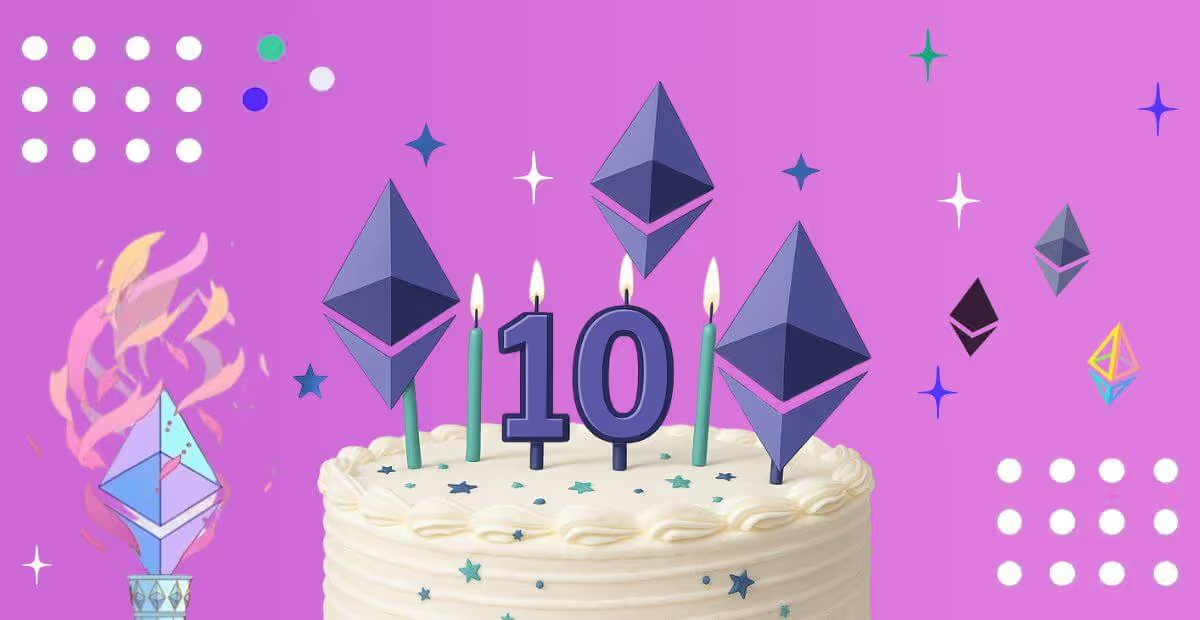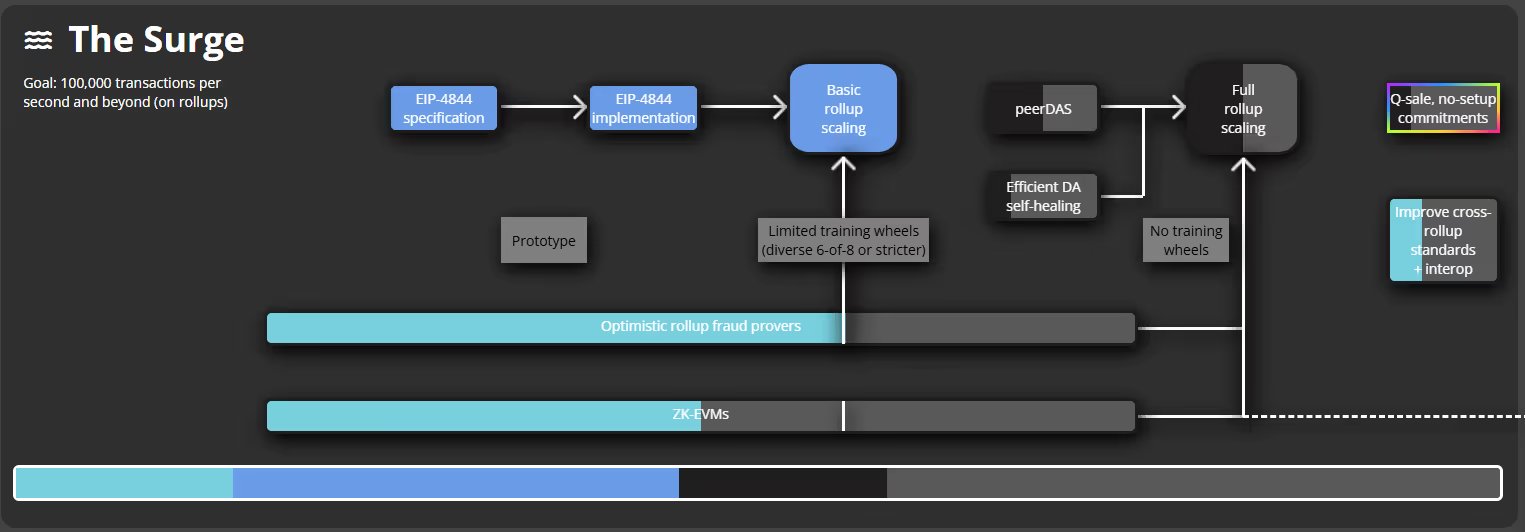Ethereum Turns 10: A Decade That Changed The Way We Build



Ten years. That’s all it took for Ethereum to go from a white paper to becoming the world’s programmable blockchain, the platform behind DeFi, NFTs, DAOs, Layer 2s, and even real-world asset tokenization.
It’s hard to believe that on July 30, 2015, a small group of developers shipped the “Frontier” release, and today Ethereum secured over $500B in value across thousands of protocols.
“ Ethereum is more than code. It’s a global community of builders. ”
– Vitalik Buterin, Devcon 2017
This one’s personal. We’ve all been working alongside Ethereum’s growth for years, and the impact it’s had on all of us is enormous. Whether you’re a builder or not, if you’re in crypto and reading this, there is a 99.9% chance that you have interacted with a smart contract once in your life.

In late 2013, Vitalik Buterin released a white paper that dared to take blockchain beyond simple transactions. He proposed a network where developers could program “smart contracts”, self-executing agreements written in code.
The idea clicked. In 2014, Ethereum raised $18M through one of the first ICOs ever. Early believers were buying ETH before there was even a live network. At $0.27 an ETH.
The Ethereum blockchain officially launched on July 30th 2015. Developers flocked to build dApps, but in mid-2016, the ecosystem faced its first existential crisis.
March 2016: Homestead upgrade introduces critical protocol improvements.
The DAO: a $150M community investment fund built on Ethereum, was hacked.
The community voted to hard-fork the chain, returning stolen funds.
That decision created Ethereum (ETH) and Ethereum Classic (ETC).
“ We had to choose: preserve immutability at all costs or protect our community’s future. Ethereum chose the latter. ”
– Gavin Wood, Co-founder of Ethereum
This event didn’t break Ethereum, it made it stronger.

2017 was the year many of us remember CryptoKitties clogging the network, a sign Ethereum wasn’t yet ready for mass scale. But it was also proof of its potential.
Oct 2017: Byzantium upgrade reduces block rewards and delays the difficulty bomb.
Feb 2019: Constantinople and later Istanbul upgrades optimize gas costs and introduce interoperability features.
Then came the DeFi summer of 2020. Projects like Uniswap, Aave, MakerDAO turned Ethereum into a global financial layer. Billions flowed into protocols, and developers shipped like crazy.
Dec 2020: Beacon Chain launches, the first step toward Proof-of-Stake (PoS).
NFTs soon followed. CryptoPunks and Bored Apes didn’t just sell jpegs, or at least they grew from it, and they built communities which unlocked cultural value.

Most of it was of course pure speculation, and we now probably all have a wallet of shame with way too many jpegs of colorful animals wearing ridiculous accessories, but it was for science, and the fun too.
Aug 2021: London upgrade introduces EIP-1559, changing the fee model and starting ETH burn.
Oct 2021: Altair upgrade improves validator penalties and adds support for light clients.
By late 2021, ETH hit an all-time high of $4,800, and Ethereum secured over $100B in Total Value Locked (TVL).
“ EIP-1559 was the first time Ethereum became deflationary at times. It changed the economic game for ETH holders. ”
– Tim Beiko, Ethereum Foundation

On September 15, 2022, Ethereum pulled off one of the most ambitious upgrades in blockchain history: The Merge.
Leading up to The Merge the Ethereum ecosystem felt electric. Devs were running final testnets, node operators were double-checking configurations, and memes about "when merge?" filled Crypto Twitter.
It was one of those rare moments when everyone, from solo stakers to DeFi giants, paused their usual hustle and waited for history to be made.
The network transitioned from Proof-of-Work to Proof-of-Stake, cutting energy usage by 99.9% and paving the way for further scalability.
“ This was like swapping out a jet engine mid-flight, and we landed smoothly. ”
– Danny Ryan, Ethereum Foundation
The Merge also introduced deflationary dynamics, with ETH supply decreasing during high activity.
Ethereum isn’t done. Vitalik’s roadmap (sources: https://ethroadmap.com/) focuses on:




Layer 2 solutions like Arbitrum, Optimism, zkSync, and Base are already leading the way. They make Ethereum cheaper and faster for builders like you.
One thing hasn’t changed in 10 years: Ethereum is still the most popular platform. It’s where builders, devs, and communities experiment. It’s where we’ve seen mistakes, lessons, and breakthroughs.
| Chain Name | Active Devs | Total Repos | Total Commits |
|---|---|---|---|
| Ethereum | 7,864 | 113,103 | 58,117,360 |
| Polygon | 2,800 | 36,766 | 22,486,300 |
| Polkadot | 2,107 | 25,037 | 22,232,604 |
| Cosmos | 2,035 | 18,145 | 17,825,617 |
| Arbitrum | 1,823 | 13,603 | 14,815,455 |
| BNB | 1,650 | 24,024 | 17,987,374 |
| Avalanche | 1,485 | 11,957 | 10,564,809 |
At Tatum, we see devs and clients shipping on Ethereum every day, whether its DeFi protocols, or tokenized real-world assets, or analytics tools.
That’s why we give you fast RPC & Data APIs for Ethereum and its L2s, with <30ms latency and indexed data out of the box.
| Chain Name | RPC Gateway Link |
|---|---|
| Ethereum | https://ethereum-mainnet.gateway.tatum.io |
| Ethereum Classic | https://ethereum-classic-mainnet.gateway.tatum.io |
| Arbitrum | https://arb-one-mainnet.gateway.tatum.io |
| Optimism | https://optimism-mainnet.gateway.tatum.io |
| Polygon | https://polygon-mainnet.gateway.tatum.io |
| Base | https://base-mainnet.gateway.tatum.io |
| zkSync | https://zksync-mainnet.gateway.tatum.io |
Ethereum’s story is still being written. If you’ve ever deployed a contract, minted an NFT, lost hundreds of usd in gas fees, or simply held ETH, you’ve been part of it.
Here’s to the next 10 years. 🥂
And if you’re building something, we’d love to see it. Tag us on X or LinkedIn with what you’re doing on Ethereum.
Build blockchain apps faster with a unified framework for 60+ blockchain protocols.